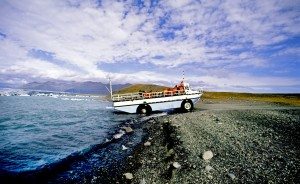
The prospect of a car that can drive off the road and into the water has intrigued inventive types for decades. Surprisingly, the first amphibious car was actually invented more than 200 years ago. TodayInSci reports that the first amphibious vehicle was the Orukter Amphibolos, invented in 1805 by Oliver Evans, and weighed in at 17 tons.
While flying cars might be a faraway dream, amphibious vehicles exist now and are constantly evolving. Here is a look at the amphibious rides of yesterday and today:
The Amphicar
Built in Germany for a short run from 1961 to 1968, the Amphicar is the only civilian amphibious automobile to have ever been mass produced. Just over 3,800 Amphicars were built, and more than 3,000 of them were imported to the U.S.
Built with a 4-cylinder Triumph Herald motor in the back capable of generating 43 hp, the Amphicar came in four colors: Fjord Green, Lagoon Blue, Beach White and Regatta Red. The Amphicar had its share of problems though — it wasn’t a very good car and it wasn’t a very good boat. Painfully slow at 7 mph in the water, the Amphicar’s ability to stay afloat all came down to a bilge pump that could fail and send the car to the bottom of a lake.
Today, enthusiasts repair and maintain them, but for the most part, the Amphicar is a failed vehicle.
Ducks
The amphibious vehicles known as “Ducks” are Amphibious DUKW vehicles designed and built by the U.S. military in 1942. Since they were needed for combat immediately, the idea was to take a pre-existing vehicle that was mass produced and make it amphibious. The result was a truck with a watertight hull, bilge pumps and marine propulsion. Capable of agile maneuvering on both land and water, Ducks were a vital asset to the American military during the war.
Today, many of the original 20,000 Ducks are in service as tour buses, offering unique perspectives of cities such as Boston, London and Seattle. For most of us, this is our best chance to get in an amphibious vehicle and take to the water.
CAMI Hyrda Spyder
Built by Cool Amphibious Manufacturers International, the CAMI Hydra Spyder is one part sports car and one part speedboat. Capable of an rpm reaching 125 mph on land and 46 knots in the water, the Spyder is packing a Corvette LS2 V8 engine under its fiberglass top, rated at 400 hp, 6,000 rpm and 400-foot pounds of torque at 4,000 rpm.
CAMI designed the Hydra Spyder to be performance driven on both land and in the water, as well as luxurious and comfortable. Capable of seating up to four people, the Spyder is built with a lightweight aluminum alloy and fiberglass hull that gives it increased performance on both land and sea. The Spyder is arguably the best looking amphibious vehicle on the water and road today.
Gibbs Aquada
Built by Gibbs Sports Amphibians from New Zealand, this amphibious vehicle was made famous when it set the record time for crossing the English Channel at one hour, 40 minutes and six seconds. Manned by Richard Branson, the Aquada that crossed the channel was powered by a V6 engine that produced up to 175 hp. Capable of speeds of 100 mph on land and 30 mph on the water, it used a jet to produce the thrust that pushed it across the water.
Unlike many other amphibious vehicles, the Aquada was built from the ground up to serve on both land and sea and is not a modified land vehicle.
Leave a Reply
You must be logged in to post a comment.